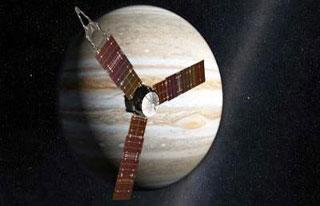
An artistic representation of NASA's Juno space probe. Photo: NASA.
NASA's Juno mission is the first dedicated mission bound for Jupiter since the Galileo probe launched in 1989.
Juno will carry nine science instruments to investigate the existence of a solid planetary core, measure the amount of water and ammonia in the deep atmosphere, map its intense magnetic field and observe the planet's auroras.
NASA has planned to launch the spacecraft by August 2011, and Juno will be able to land on the surface of the Jupiter only by 2016. In one year, Juno will complete the mission by orbiting the planet 32 times.
Juno will reveal the origin and evolution of Jupiter and help us to understand the beginning of our solar system.
Jupiter is the largest planet of our solar system, which is also known as a gas giant.
Juno is programmed mainly to attain the following:
• To determine the presence of water in the Jupiter’s atmosphere, this will help to find the exact theory behind the formation of the planet
• To get the accurate data of the complex climate, which includes composition, temperature, cloud motions and other properties
• Map Jupiter’s magnetic and gravity fields, revealing the planet’s deep structure
• Explore and study Jupiter’s magnetosphere near the planet’s poles, especially the auroras – Jupiter’s northern and southern lights – providing new insights about how the planet’s enormous magnetic force field affects its atmosphere.
 Previous Article
Previous Article Next Article
Next Article












The Indian Air Force, in its flight trials evaluation report submitted before the Defence Ministry l..
view articleAn insight into the Medium Multi-Role Combat Aircraft competition...
view articleSky enthusiasts can now spot the International Space Station (ISS) commanded by Indian-American astr..
view article